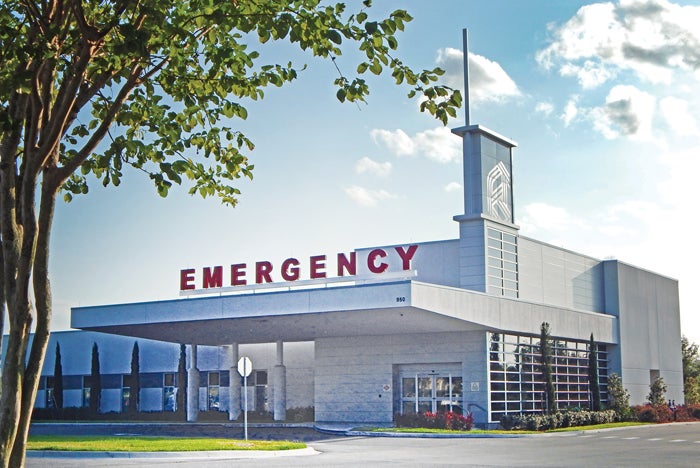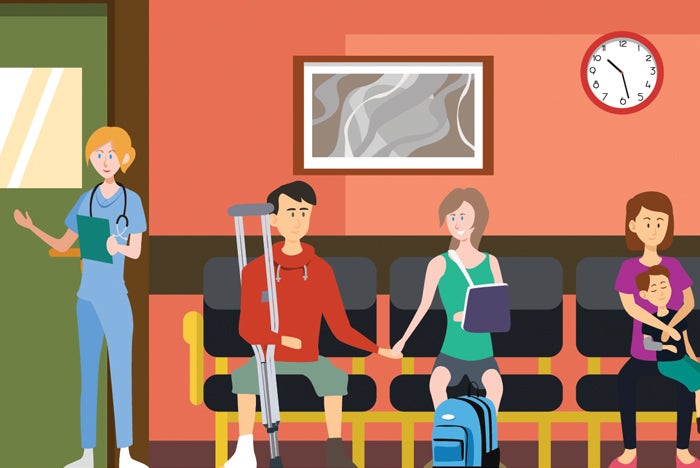Planning a remote emergency department

One of Florida Hospital’s prototype freestanding EDs designed by HuntonBrady Architects, Orlando, Fla., is located in Lake Mary, Fla.
Image by TLC Engineering for Architecture
As of 2016, there were more than 500 freestanding emergency departments (EDs) across the country, according to the Medicare Payment Advisory Commission. To put this in perspective, there is roughly one freestanding ED for every 10 hospitals today.
These freestanding EDs generally come in two types: the outpost/feeder model that is never envisioned as something more; and the expandable, remote ED model that may be expanded for future growth.
Both models come with distinct infrastructure and construction challenges.
Outpost/feeder factors
The outpost/feeder freestanding EDs are often squeezed into unique and interesting places, including supermarkets, gyms and simple office spaces. As big-box retailers struggle to keep up with online shopping, it is easy to envision them as prime targets for conversion to remote EDs in the future.
Indeed, big-box spaces offer two features that could account for a large part of the total project budget for a new building: existing buildings and ample parking. They are typically in great locations, accessible to patients and near their communities.
However, big-box spaces typically do not have sufficient infrastructure and are not designed for I-2, or institutional, occupancy. Consequently, health facility professionals must consider the following elements in any conversion:
Space separation Where is the demising wall between the two occupancy types and how does this affect the exiting strategy of the remote ED and any adjacent existing space? The location of the wall, the routing and where the opening ends up are critical to the exiting, the infrastructure and the security of the new ED.
Structural issues. | Several key support items that may be added often require structural evaluation. Most remote EDs minimally have an X-ray and, possibly, a computed tomography scanner or other equipment, both of which have substantial weight. Also, the utilities, air-handling units and generators are larger and heavier than they would be with other building types. Can the structure support all of this?
Mechanical system. Mechanically, any conversion often will include demolishing the existing system and rebuilding a new system. Most building types utilize return-air plenums, which are not accepted in hospital environments. Existing ductwork is sized to allow for fewer air changes than will be required for a remote ED. And, in an ED, exhaust plays a critical role in the isolation areas, as well as in the waiting rooms. Often, a new air-handling unit will be required to handle the capacity of the space, which, in turn, requires that the structure accommodate the larger air-handling unit. A designer also may have to include provisions for a lab, a remote pharmacy or even a local central sterile department.
Plumbing and medical gas. While there is no medical gas system in nonhealth care spaces, a remote ED is still required to have gases. This often means that facility professionals need to allocate space for bottle storage somewhere within the I-2 area, as well as a medical vacuum pump and medical air compressor. Facility professionals also may need specialty gases in the trauma rooms within the ED. Boilers and hot water heaters also are required to be within the I-2 area as they serve the ED.
Although there are allowances in the code for sharing services, it’s the I-2 space that has to house and control these utilities and be able to shut off service to any other area where it is shared. An often overlooked element is that remote EDs also may require some type of lab function. This may require water that has been filtered or treated.
Electrical system. This is probably the space in which facility professionals can see the most rework coupled with the most temptation to keep existing infrastructure. Often, utility companies have service to a common location, with submetering already defined, which is unlikely to meet the requirements for new service.
A few key questions need to be asked at the outset: Can a fault or event on other tenants affect the operation of the ED? Do the other tenants selectively coordinate with the ED space’s service? Is the service entrance located inside the I-2 area, as it should be, or outside of it? Is the service big enough? Who has control and access to the service distribution? Is there anything on the existing system that would affect sensitive electronics typically found within the remote ED, like X-ray equipment?
The other key element of the electrical service is the essential electrical system, including the generator and transfer switches. The remote ED still requires Type I separation among life-safety, critical and equipment branches, and maintenance of power to patients as required by the National Fire Protection Association’s NFPA 70, National Electrical Code. The remote ED also would require fuel storage for this system, and fuel that is separated from consumption from other tenants. Distribution and circuiting within the space often results in new equipment and distribution. All of this would have to reside within the I-2 area.
Fire alarm. This is an odd one. It is separate but often connected to the main fire alarm panel for the building. It makes sense that the remote ED should know what is going on in a neighbor’s area, but should be designed as a survivable system that will continue to function if the adjacent areas have a fire event for at least two hours per NFPA 72, National Fire Alarm and Signaling Code. The notification of tenants for evacuation often will be handled differently for the remote ED than for other tenants and should be designed as such, but it is not a completely separate system.
Low-voltage areas. These have grown substantially in the last several code revisions. This space requires a remote data center that often connects back to the central servers for the complete hospital system. Remote EDs have also been used as the off-site backup location for data centers, which only serves to increase the remote ED’s size and needs.
Security. This is another unique consideration. The tenant that was previously in the space probably wasn’t open all the time as a remote ED would be. Is there enough lighting and is it on 24/7? What about cameras and security stations?
The outpost remote ED model is highly flexible and can be squeezed into many different locations, but it will only be a remote ED and never anything more.
Flexible ED issues
Health care organizations often will consider the development of a freestanding ED as the first step to creating a new hospital at a given location. This is often seen in growing communities and states where the growth in population creates new needs.
How can health facility professionals make a freestanding ED meet a competitive budget, but also be able to grow? Careful assessments must be made, because the budget is never large enough to size infrastructure for a hospital at the outset.
This type of remote ED has many similar challenges to the outpost style, but also some distinct differences. The following elements must be considered by health facility professionals:
Site planning. The four flows of traffic on the site need to be considered up front. Patients, staff, deliveries and ambulances all have distinct needs and destinations, and all will be impacted by the future expansion of the ED. How the site is planned is as important to the design as anything, because it affects the long-term outcome and limitations of any hospital.
Utility location. The location of utility services entering the site are as important as the easements they come with and are not simple to move at a later time. Sizing of utilities up front for long-term growth can have capital cost investments up front if not negotiated carefully with utility providers.
Central energy plant (CEP). A health facility professional may need the same size utilities as other remote ED options, but the location will be drastically different because it requires significant planning and thought toward the long term.
An ED in a hospital feeds to surgery, diagnostic imaging and inpatient beds, and requires connectivity to patient care areas on as many sides as possible. It may not make sense that a single structure covers the project and a separate CEP can be an option to allow for growth toward the long term. The CEP also needs to be planned for growth, so putting it in a location to do so makes the most sense for the long term.
The configuration of the plant can go a long way toward driving energy efficiency of the future hospital. Elements such as combined heat and power plants or heat-recovery chillers are wonderful tools for a hospital to reduce energy consumption that don’t always make sense for a freestanding ED.
Emergency power. This is an area that would benefit from strategic design to allow for flexibility. One option would be to design a system that utilizes parallel generators and can allow for the growth of the system by adding more generators later. Another might be to plan a single generator for the ED that can be paralleled with a future multigenerator system.
Chilled water system. This typically would be sized as modules with N+1 availability. This would allow for the growth of the building and supplemental chillers to be added to the plant. It may make sense to plan it for future building, but this would require a piping system that is designed and sized based on the final layout of the plant.
Tie-In locations. Where valves and spare conduits are located, and where shutdowns would have to occur would need to be part of the design and considerations for the expansion of the facility. Once the ED is open, it can’t be closed and all connections would have to be made while the building is in use. Strategic valve planning and thinking are critical to the design and paramount to protect the future operation of the ED.
Other systems. There are other systems that need to be considered as well. Hospital EDs have access to things like a pneumatic tube system that will not be put in Day 1 but, ideally, should be planned for future inclusion. Medical gas expansion is another consideration, because a hospital needs a full oxygen tank farm while a remote ED only requires bottle storage.
Scope creep is often a concern with the expansion ED. Consider that increasing a switchboard from 3,000 to 4,000 amps typically only requires the bus to increase size (minimal cost), but the room may grow, the feeders will grow and capacity is still based on future projections. It may make sense, but one would need to be mindful of cost escalations that quickly add up if everything is done in the base project.
Great starting point
With today’s shifting and aging population, remote EDs likely are here to stay. In fact, it is not surprising that many of these occur in growing populations like Texas, Florida or fast-growing cities like Denver.
They are a great starting point to bringing care even closer to the community. However, the long-term goals of the project should be discussed up front to ensure clarity of purpose.
James Ferris is chief operating officer at TLC Engineering for Architecture, headquartered in Orlando, Fla. He can be reached at James.ferris@tlc-eng.com.





